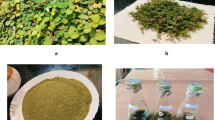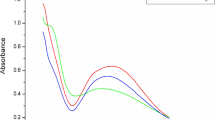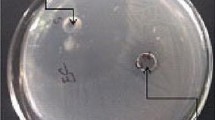Abstract
Safe, durable and environmentally friendly antimicrobial textiles are in great demand in the market nowadays. The present investigation aims to assess antibacterial properties of Mikania micrantha leaf extract as a sustainable textile finish. The methodology utilized solvent extraction using pure methanol (100%) and application via pad-dry technique on various fabric types, supplemented with 7% citric acid as a crosslinking agent to enhance durability. The AATCC 90:2011 method was used to determine antibacterial activity of the treated fabrics against Staphylococcus aureus (MTCC 7443). Standard techniques were used to characterize the pre- and post-treated textiles, including fabric weight, thickness, crease recovery angle, elongation, stiffness, tensile strength and SEM. The treated fabrics demonstrated a significant (p ≤ 0.05) inhibition zone: Eri/Cotton (21.22 mm) > Eri/Eri (19.00 mm) > Eri/Mulberry (18.67 mm). It was noted that these key physical attributes were not being adversely affected by the finish. Even after ten (10) washes, the fabrics were found to exhibit a significant (p ≤ 0.05) antibacterial activity in the order of Eri/Mulberry (11.22 mm) > Eri/Eri (10.22 mm) > Eri/Cotton (8.00 mm). The findings of the present study indicate that the invasive Mikania micrantha leaves extract has potential as a promising and safer alternative for antimicrobial finishing and its application in textile and medical industries, with a keen focus on mitigating environmental impact.
Graphical Abstract







Similar content being viewed by others
Availability of data and materials
Data will be made available on request.
References
N.O. Sanli, Eur. J. Bio 67, 115 (2008)
A. Varesano, C. Vineis, A. Aluigi, F. Rombaldoni, Sc. Ag. Mic. Path. Com. Cur. Res. Tech. Adv. 3, 99 (2011)
A.R. Horrocks, S. Anand, Handbook of Technical Textiles (CRC Press, Woodhead Pub, 2000), pp.1–40
W.D. Schindler, P.J. Hauser, Chemical Finishing of Textiles (CRC Press, Boca Raton, 2004), pp.165–172
R.R. Roth, W.D. James, L.T. Col, E.F. Base, W. Alaska, J. Am. Aca. Derm. 20, 367 (1989). https://doi.org/10.1016/S0190-9622(89)70048-7
E.A. Grice, H.H. Kong, S. Conlan, C.B. Deming, J. Davis, A.C. Young, G.G. Bouffard, R.W. Blakesley, P.R. Murray, E.D. Green, M.L. Turner, S J. A. Segre. Science 1979(324), 1190 (2009). https://doi.org/10.1126/Science.1171700
Z Rajabi, AM Sefidan, M Zarebavani, SS Yazdi, PT Bonab, SZ Mirbagheri, MMS Dallal, (2023) J Food Qual Hazards Control. 10:221, https://doi.org/10.18502/jfqhc.10.4.14180.
H.F. Chambers, F.R. DeLeo, Nat. Rev. Microbiol. 7, 629 (2009). https://doi.org/10.1038/nrmicro2200
G. Gherardi, Staphylococcus aureus infection: pathogenesis and antimicrobial resistance. Int. J. Mol. Sci. 24(9), 8182 (2023). https://doi.org/10.3390/ijms24098182
E. Heine, H.G. Knops, K. Schaefer, P. Vangeyte, M. Moeller, Mul. Fun. Bar. Flex. Str. 23, 28 (2007). https://doi.org/10.1007/978-3-540-71920-5_2
A. Narayan, A. Banerjee, A. Majumdar, D.B. Datta, J. Inst. Eng. India Ser. E 103, 233 (2022). https://doi.org/10.1007/s40034-022-00237-5
V.G. Nadiger, S.R. Shukla, Antimicrobial activity of silk treated with aloe-vera. Fibers and Polymers 16, 1012 (2015). https://doi.org/10.1007/s12221-015-1012-y
G. Deshmukh, Man. Tex. In Ind. 52, 421 (2009)
B. Das, N.V. Padaki, K. Jagannathan, B. Hubballi, S.V. Naik, in Procedia Eng. Elsevier Ltd: Amsterdam 53, 60 (2017). https://doi.org/10.1016/j.proeng.2017.07.009
T. Ramachandran, R. Kumar, R. Rajendran, IE (I) Journal-TX 2, 42 (2004)
Y. Gao, R. Cranston, Text. Res. J. 78, 60 (2008). https://doi.org/10.1177/0040517507082332
M. Gobalakrishnan, D. Saravanan, S. Das, Sustainable finishing process using natural ingredients. Sustainability in the Textile and Apparel Industries 1, 129–146 (2020). https://doi.org/10.1007/978-3-030-38545-3_5
S. Sfameni, M. Hadhri, G. Rando, D. Drommi, G. Rosace, V. Trovato, M.R. Plutino, Inorganic finishing for textile fabrics: recent advances in wear-resistant, UV protection and antimicrobial treatments. Inorganics. 11(1), 19 (2023). https://doi.org/10.3390/inorganics11010019
T. Arai, G. Freddi, G.M. Colonna, E. Scotti, A. Boschi, R. Murakami, M. Tsukada, J App Poly 80, 297 (2001). https://doi.org/10.1002/1097-4628(20010411)80
G. Thilagavathi, T. Kannaian, Ind. J. Nat Pro. & Res. 1, 348 (2010)
S.S. Abkenar, R.M.A. Malek, Fibers and Polymers 25, 83 (2024). https://doi.org/10.1007/s12221-023-00403-5
A.K. Samanta, P. Agarwal, Ind. J. Fib. & Tex. Res. 34, 384 (2009)
A. El-Shafei, S. Sharaf, S. Zaghloul, M. Hashem, Int. J. Pharm Tech Res 8, 123 (2015)
M.P. Sathianarayanan, N.V. Bhat, S. Kokate, V.E. Walunj, Ind. J. Tex. Res. 35, 50 (2010)
M Borkataky B Kakoti L Saikia 2013 Int. J. Phar. Sc. Rev. & Res. 23 116
M. Naebe, A.N.M.A. Haque, A. Haji, Engineering 12, 145 (2022). https://doi.org/10.1016/j.eng.2021.01.011
M. Orhan, D. Kut, C. Gunesoglu, J. Appl. Polym. Sci. 111, 1344 (2009). https://doi.org/10.1002/app.25083
M.M. Hassan, I.J. Fowler, Int. J. Biol. Macromol. 205, 55 (2022). https://doi.org/10.1016/j.ijbiomac.2022.02.017
H.M.C. Azeredo, K.W. Waldron, Trends Food Sci. Technol. 52, 109 (2016). https://doi.org/10.1016/j.tifs.2016.04.008
H. Dinesh, J. Wang, Kim, Glo. Cha. 6, 2200090 (2020). https://doi.org/10.1002/gch2.202200090
R. Jantas, K. Gorna, Fib and tex. In Easte. Euro 14, 88 (2006)
D.T. Seshadri, N.V. Bhat, Sen’i Gakkaishi 61, 4 (2005)
L Gunasekera 2009 Invasive Plants: A Guide to the Identification of the Most Invasive Plants of Sri Lanka
Y. Li, J. Li, Y. Li, X. Wang, A.-C. Cao, Antimicrobial constituents of the leaves of Mikania micrantha H. B. K. PLoS ONE 8, 2 (2018). https://doi.org/10.1371/journal.pone.0076725
L.Y. Zhang, W.H. Ye, H.L. Cao, H.L. Feng, Mikania Micrantha H. B. K. in China-an Overview 44, 42 (2004). https://doi.org/10.1111/j.1365-3180.2003.00371.x
A. Dey and J. N. De, Afr. J. Tradit. Complement. Altern. Med. 9 (2012). https://doi.org/10.4314/ajtcam.v9i1.20
W. Herz, A. Srińivasan, P.S. Kalyanaraman, Phytochem. 14, 233 (1975). https://doi.org/10.1016/0031-9422(75)85045-X
G. Nicollier, A.C. Thompson, Phytochem. 20, 2587 (1981). https://doi.org/10.1016/0031-9422(81)83102-0
R. Boeker, J. Jakupovic, F. Bohlmann, G. Schmeda-Hirschmann, Planta Med. 53, 105 (1987). https://doi.org/10.1055/s-2006-962638
M.D.R. Cuenca, A. Bardon, C.A.N. Catalan, W.C.M.C. Kokke, J. Nat. Prod. 51, 625 (1988). https://doi.org/10.1021/np50057a040
H. Huang, W. Ye, P. Wu, L. Lin, X. Wei, J. Nat. Prod. 67, 734 (2004). https://doi.org/10.1021/np034027i
Q. Xu, H. **e, H. **ao, L. Lin, X. Wei, Phytochem. Lett. 6, 425 (2013). https://doi.org/10.1016/j.phytol.2013.05.007
P.-H. But, Z.-D. He, S.-C. Ma, Y.-M. Chan, P.-C. Shaw, W.-C. Ye, R.-W. Jiang, J. Nat. Prod. 72, 925 (2009). https://doi.org/10.1021/np800542t
L. Yan, S. Bin, L. Jun, L. Yuan, W. **a, C. Ao-Cheng, Afr J Microbiol Res 7, 2409 (2013). https://doi.org/10.5897/AJMR2013.5451
H. Abdelbagi, M. Ahmed, Appl. Chem. 45, 7840 (2012)
J. Parekh, D. Jadeja, S. Chanda, Tur. J. Biol. 29, 203 (2005)
V.B. Jayswal, V.H. Patel, N.R. Dave, Appl Biol Res 23, 129 (2021). https://doi.org/10.5958/0974-4517.2021.00018.5
AATCC Test Method 90–2011, Antibacterial Activity Assessment of Textile Materials: Agar Plate Method (Research Triangle Park, NC, 2012), pp. 124–125.
Textiles-Domestic washing and drying procedures for textile testing, ISO 6330E, 1–8 (1984)
C.J. Jahagirdar, L.B. Tiwari, Pramana 62, 1099 (2004). https://doi.org/10.1007/BF02705256
J.E. Booth, Fabric Dimensions and Properties: Principles of Textiles Testing (CBS Publishers and Distributors, New Delhi, 1996), pp.432–449
Anonymous, Wrinkle Recovery of Woven Fabrics: Recovery Angle, AATCC Test Method 66–2008 (Research Triangle Park, American Association of Textile Chemists and Colorists, 2010), pp.91–94
Anonymous 2008 Method for Breaking Force and Elongation of Textile Fabrics (Strip Method), ASTM D 5035–06
PV Mehta SK Bhardwaj (1988) Managing Quality in the Apparel Industtry New Age International (P) Ltd., Publishers
V.G. Nadiger, S.R. Shukla, Int. J. fib and Tex. Res. 42, 465 (2017)
U.K. Dev, M.T. Hossain, M.Z. Islam, A.T. Hossain, Wor. J. of Phar. Res. 5, 121 (2015)
C.J. Lim, M. Arumugam, C.K. Lim, G.C.L. Ee, Journal of Natural Fibers 17, 726 (2020). https://doi.org/10.1080/15440478.2018.1527742
N. Hassan, R. Halis, N.M. Esa, Int. J. of Agri. 10, 209 (2020)
E Sjostrom 1993 Wood Chemistry: Fundamentals and Applications Academic press INC: Cambridge 180 181 https://doi.org/10.1016/B978-0-08-092589-9.50003-6
J. Dai, R.J. Mumper, Molecules 15, 7313 (2010). https://doi.org/10.3390/molecules15107313
I.B. Sumantri, H.S. Wahyuni, L.F. Mustanti, Pharmacognosy Journal 12, 1395 (2020). https://doi.org/10.5530/pj.2020.12.193
M.M.G. Fouda, H.M. Fahmy, Carbohydr. Polym. 86, 625 (2011). https://doi.org/10.1016/j.carbpol.2011.04.086
A.M. El-Shafei, M.M.G. Fouda, D. Knittel, E. Schollmeyer, J. Appl. Polym. Sci. 110, 1289 (2008). https://doi.org/10.1002/app.28352
M. Salimi, V. Pirouzfar, E. Kianfar, Colloid Polym. Sci. 295, 215 (2017). https://doi.org/10.1007/s00396-016-3998-0
P. Djarot, N.F. Utami, N. Veonicha, A. Rahmadini, A.N. Iman, Systematic Reviews in Pharmacy 11, 322 (2020)
K.M. Craft, J.M. Nguyen, L.J. Berg, S.D. Townsend, Med. chem. comm 10, 1231 (2019). https://doi.org/10.1039/C9MD00044E
W.Y. Wang, J.C. Chiou, J. Yip, K.F. Yung, C.W. Kan, Coatings 10, 520 (2020). https://doi.org/10.3390/coatings10060520
S. Perera, B. Bhushan, R. Bandara, G. Rajapakse, S. Rajapakse, C. Bandara, Colloids Surf A Physicochem Eng Asp 436, 975 (2013). https://doi.org/10.1016/j.colsurfa.2013.08.038
M.E. El-Naggar, S. Shaarawy, A. El Shafie, A. Hebeish, Fibers and Polymers 18, 1486 (2017)
G. Thilagavthi, T. Kannaian, Natural Product Radiance 7, 330 (2008)
M. Montazer, F. Alimohammadi, A. Shamei, M.K. Rahimi, Colloids Surf. B Biointerfaces 89, 196 (2012). https://doi.org/10.1016/j.colsurfb.2011.09.015
A. Sahu, A. Devkota, Int. J. Eco. 23, 1 (2016). https://doi.org/10.3126/eco.v23i0.20646
M.Y. Nasution, M. Restuati, R.A. Syahputra, A. Shafwan, S. Pulungan, J. Bio. Sc. Res. 16, 793 (2019)
M. Miklasińska-Majdanik, M. Kępa, R.D. Wojtyczka, D. Idzik, T.J. Wąsik, Phenolic compounds diminish antibiotic resistance of Staphylococcus aureus clinical strains. Int. J. Environ. Res. Public Health 15(10), 2321 (2018). https://doi.org/10.3390/ijerph15102321
A.G. González, L. Moujir, I.L. Bazzocchi, M.D. Correa, M.P. Gupta, Phytomedicine 1, 149 (1994). https://doi.org/10.1016/S0944-7113(11)80034-6
J. U. Ewansiha,S. A. Garba, J. D. Mawak, O. A. Oyewole, Front. Sci. 2, 214 (2012).https://doi.org/10.5923/j.fs.20120206.14
S.Y. Pan, S.F. Zhou, S.H. Gao, Z.L. Yu, S.F. Zhang, M.K. Tang, J.N. Sun, D.L. Ma, Y.F. Han, W.F. Fong, K.M. Ko, Evi. Bas. Com. Alt. Med. 2013, 1 (2013). https://doi.org/10.1155/2013/627375
D.P. Pavarini, S.P. Pavarini, M. Niehues, N.P. Lopes, Anim. Feed Sci. Technol. 176, 5 (2012). https://doi.org/10.1016/j.anifeedsci.2012.07.002
B.P. Saville, Physical Testing of Textiles (Woodhead Publishing Limited, Cambridge, 2012), pp.1–5
S. Kawabata, M. Niwa, J. Text. Inst. 80, 19 (1989). https://doi.org/10.1080/00405008908659184
A Das 2013 Process Control in Textile Manufacturing 41 https://doi.org/10.1533/9780857095633.1.41
R Kavitha 2013 Evaluation of selected herbal antimicrobial finish for development of sustainable bamboo: cotton bandage Doc. Thes. Van. Vid., Ind. Shodh 35 1
N Gokarneshan 2019 J. of Nur. and Pat. Hea. Care 1 1 https://doi.org/10.1016/B978-0-08-102192-7.00019-9
G. Taga, B. Kalita, Journal of Academia and Industrial Research 2, 252 (2013)
S. Saikia, M. Saikia, The Pharma Innovation 11, 732 (2022). http://www.thepharmajournal.com
SV Lomov AV Truevtzev C Cassidy 2000 Tex. Res. J. 70 1088 https://doi.org/10.1177/004051750007001208.
M.M. Sheam, Z. Haque, Z. Nain, 3, 92 (2020). Biotechnol Exp Ther 3, 92 (2020). https://doi.org/10.5455/jabet.2020.d112
I. Jahan, Adv. Res. in Text. Engg. 2, 1018 (2017)
K.L. Pickering, M.G.A. Efendy, T.M. Le, Compos. Part A Appl. Sci. Manuf. 83, 98 (2016). https://doi.org/10.1016/j.compositesa.2015.08.038
R. Rajkhowa, V.B. Gupta, V.K. Kothari, J. of app. Pol. Sc. 77, 2418 (2000). https://doi.org/10.1002/1097-4628(20000912)77:11%3c2418
G. Melesse, D. Atalie, A. Koyrita, Adv. Mater. Sci. Eng. 2020, 1 (2020). https://doi.org/10.1155/2020/9750393
K. Wakatsuki, S. Onoda, M. Matsubara, N. Watanabe, L. Bao, H. Morikawa, Polymers (Basel) 14, 3948 (2022). https://doi.org/10.3390/polym1419394
N. Pan, Analysis of woven fabric strengths: prediction of fabric strength under uniaxial and biaxial extensions 56, 311 (1996). https://doi.org/10.1016/0266-3538(95)00114-X
I. Jasińska, Sci. Rep. 13, 12214 (2023). https://doi.org/10.1038/s41598-023-38969-y
Acknowledgements
The authors would like to thank Dr. V. H. Patel (Professor and Head) and Dr. Viraj Roghelia (Associate Professor), Post Graduate Department of Home Science, Vallabh Vidyanagar, Anand, Gujarat, India for extending their valuable guidance during the study.
Funding
The authors declare that no funds, grants, or other support were received during the preparation of this manuscript.
Author information
Authors and Affiliations
Contributions
Rupjyoti Neog: investigation, formal analysis, methodology, and writing—original draft. Namrita Kola: conceptualization, supervision, writing—review and editing the paper.
Corresponding author
Ethics declarations
Conflict of Interest
The authors have declared no conflicts of interest for this article.
Rights and permissions
Springer Nature or its licensor (e.g. a society or other partner) holds exclusive rights to this article under a publishing agreement with the author(s) or other rightsholder(s); author self-archiving of the accepted manuscript version of this article is solely governed by the terms of such publishing agreement and applicable law.
About this article
Cite this article
Neog, R., Kola, N. An In Vitro Analysis of Antibacterial Property of Mikania micrantha Leaves Extract as a Textile Finish with Crosslinking Agent and Its Washing Efficacy. Fibers Polym 25, 2569–2583 (2024). https://doi.org/10.1007/s12221-024-00593-6
Received:
Revised:
Accepted:
Published:
Issue Date:
DOI: https://doi.org/10.1007/s12221-024-00593-6




